|
This backlit sunflower image was created the afternoon before Denise Ippolito’s A Creative Adventure sunflower workshop in Newton, NJ in early August. I used my favorite new macro rig, the 500 f/4L IS II: Canon 500mm f/4L IS II lens and the Canon EOS-5D Mark III. ISO 400. Evaluative metering +1/3 stop: 1/13 sec. at f/16 in Av mode. Central sensor/AI Servo Surround/Rear Focus AF on the flower center and recompose. Click here if you missed the Rear Focus Tutorial. Click on the image for a larger version. |
Leaf Too Long? Confessions of an Edge-Freak
I loved the backlight here and made several images moving a bit to the left or right. This was my favorite frame because it had the nicest background and because it had the strongest backlight. But. I clipped the leaf on the edge of the frame. For me, that is a cardinal sin. I tried bringing in the tip of the leaf from one of the properly framed images, but nothing worked despite repeated attempts. So I gave up.
|
Here is a close-up view of my crime. |
In the Art of Bird Photography II in the chapter on Advanced Composition and Image Design I (think that I wrote) “If an object is worth including in the frame be sure to include the whole thing with at least a small border.” If I did not write that there, I have said is a thousand times here, at seminars, and on IPTs. Become an Edge-Freak. It is much easier to deal with objects that merge with the frame edge in the field than it is in post processing.
In Digital Basics I wrote something to this effect: “We have taught you how to use lots of tools and we have taught you many techniques, but sometimes you need to put your thinking cap on, get creative, and come up with something new.
|
Here is a close-up view of of the repaired leaf. |
I came across this image yesterday and suddenly a plan to repair the leaf came to mind. I made a Quick Mask of the upper edge of the leaf and put it on its own layer. I moved it to my right a bit, re-positioned it, and warped it. I left the layer intact, went back to the background layer, painted a Quick Mask of the lower edge of the lead, and repeated the additional steps above. Then I added a Layer Mask to each of the two edge layers and painted away as needed to give the now shortened leaf a nice point. All that was left was to paint a third Quick Mask with some brown center of the sunflower behind the formerly offending leaf, move it into place, add a Layer Mask, and paint away as needed to reveal the pointy tip of the new leaf below. It sounds like a lot of work but actually took about four minutes. That compared to the 40 minutes that I spent on my misguided efforts.
Most everything above is covered in detail in Digital Basics. Advanced Quick Masking Techniques including warping and re-positioning are covered in APTATS I.
|
This is the optimized image; note that the leaf is not longer clipped. Let’s call this Image A. |
I was not sure that I liked all the specular highlights in the optimized image so I went back to work using the Clone Stamp Tool at reduced opacity, varying between 40 and 70%.
|
This is the image after I dealt with the specular highlights. Let’s call this Image B. |
Do understand that our the image directly above, Image B, is what our eyes would see. The specular highlights are caused by points of light being reflected (if that is the right word) off internal lens elements.
Which Do You Like Better?
Take a moment to let us know which image you like better, Image A or Image B. And be sure to let us know why.
Delkin 700X CompactFlash Pro UDMA Enabled Cards
You can learn more about Delkin’s new 700X CompactFlash Pro UDMA Enabled Cards by clicking here and learn why the 1000X cards are overkill for still photographers. These cards are as important to my 5DIII as the batteries in the vertical battery grip!
Shopper’s Guide
Below is a list of the gear used to create the images in today’s post. Thanks a stack to all who have used the Shopper’s Guide links to purchase their gear as a thank you for all the free information that we bring you on the Blog and in the Bulletins. Before you purchase anything be sure to check out the advice in our Shopper’s Guide.
Canon 500mm f/4L IS II lensI decided to leave the 800 at home for the bear boat trip and quickly fell in love with the 500 II for its light weight, great versatility, and four-stop IS. A complete review will be coming soon.
Canon EOS-5D Mark III. Man, I am in love with this camera body. Both the files and the AF system are superb.
And from the BAA On-line Store:
LensCoats. I have a LensCoat on each of my big lenses to protect them from nicks and thus increase their re-sales value. All my big lens LensCoat stuff is in Hardwood Snow pattern.
LegCoat Tripod Leg Covers. I have four tripods active and each has a Hardwood Snow LegCoat on it to help prevent further damage to my tender shoulders 🙂 And you will love them in mega-cold weather….
Gizo GT3532 LS CF Tripod. This one replaces the GT3530LS Tripod and will last you a lifetime. I’ll be commenting on this new model soon. In short, I like it.
Mongoose M3.6 Tripod Head. Right now this is the best tripod head around for use with lenses that weigh less than 9 pounds. For heavier lenses, check out the Wimberley V2 head.
Double Bubble Level. You will find one in my camera’s hot shoe whenever I am not using flash.
The Lens Align Mark II. I use the Lens Align Mark II pretty much religiously to micro-adjust all of my gear an average of once a month and always before a major trip. Enjoy our free comprehensive tutorial here.
BreezeBrowser. I do not see how any digital photographer can exist without this program.

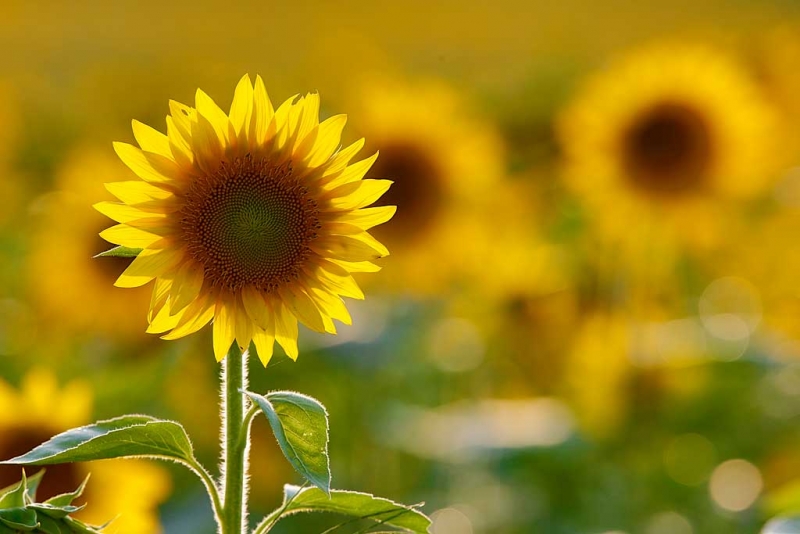
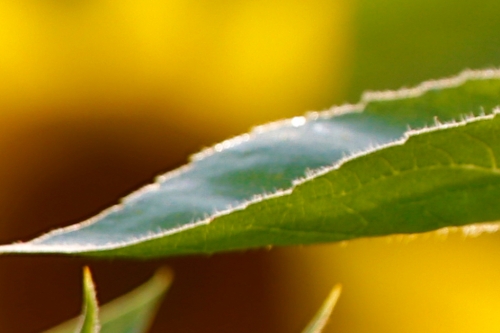
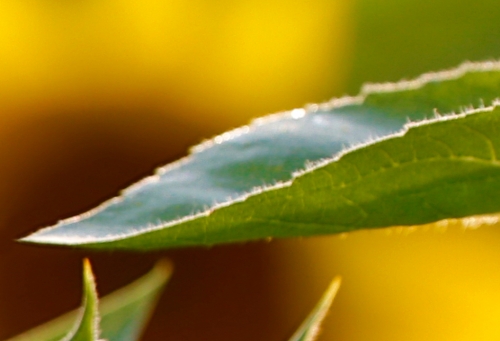
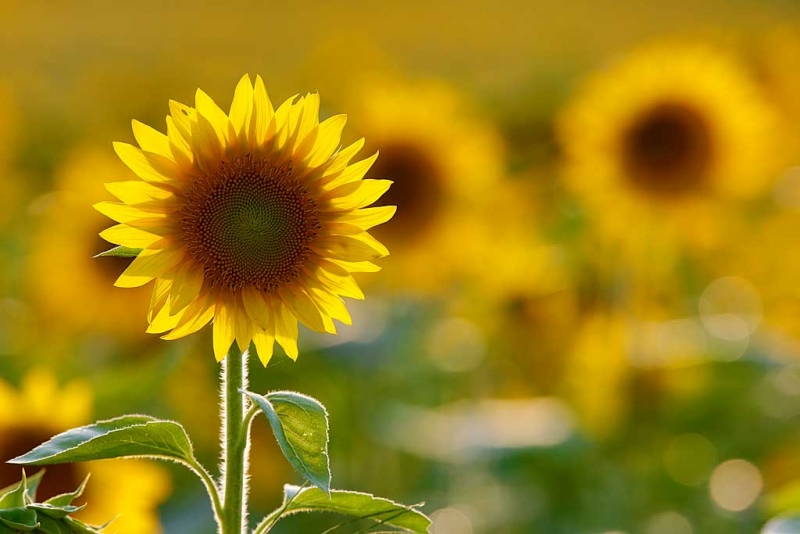
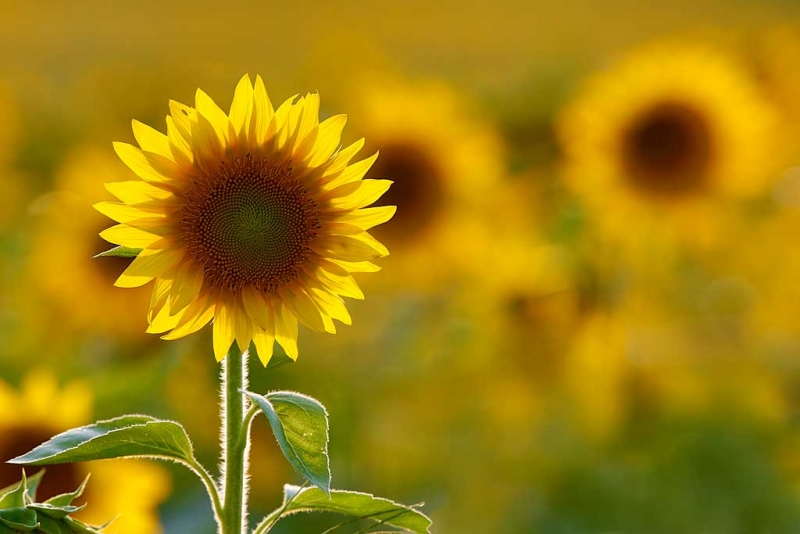













Love it! Nice clean up and the sunflower really shines!
Excellent work and thinking to deal with that leaf I must say! Doubt I would’ve thought about doing that. Maybe I would have eliminated some but not all of the specular highlights, I think the circular ones balance the image nicely. All in all a great end product.
Here is a very interesting discovery: the original image here was not from a RAW file. It was from a 3-frame HDR created in-camera with the 5D MIII. And guess what? I did not clip the leaf in any of the 3 original frames from which the HDR JPEG was created. That is one negative of the 5D III’ HDR feature–the final image is cropped a bit from the original framing….
B is better and I agree on everything. Backlit sunflowers rock!
To all those below who liked the specular highlights or commented on them. I like the circular ones far better than the rectangular ones. The problem with removing the long skinny ones only is that they each overlap a circular one. It could have been done. If I had to choose one I would probably go with A over B by the slimmest of margins as the specular highlight add to the backlit effect (more than they detract from the overall image). IMMO :). artie
Thanks Crappy Patti :). You too. Did you enter the Gatorland contest?
Hi, Artie, and thanks. I prefer image B as well, but a couple of questions. First, do I understand correctly that you in effect clipped the leaf in Photoshop, allowing its shortened tip to clear the frame? Second, if you had noticed the leaf when taking the photo, would the problem have been solved by your taking one step backward? (Aiming the camera a bit to the left wouldn’t have worked because then you’d have lost good stuff from the right side of the image.) It’s a wonderful image in any case.
I clipped it in the field and shortened it in PS to clear the frame. In the field, all that I needed to go was pay attention and point the lens 1/4 inch to the left or 1/4 step back…
I prefer B also, the highlights in A are kind of distracting. While you working your Photoshop magic I’m surprised you didn’t repair the holes in the petals on the top of the sunflower.
I’ve been trying to stay away from “too perfect.”
This image really shows your rule of crop don’t clip (or maybe you say it differently, can’t remember). The added canvas to restore that bit of leaf tip makes a big difference to me. In fact, if this image were to be framed (where the mat has to overlap the image a bit) you would probably need even more canvas on the left. My choice is image B without the distracting highlights. But, like some other folks mention, I’d like to see a version C with only circular highlights showing, not the long ones. I am fond of circular highlights if they seem to work. Somehow the right leaf clip doesn’t bother me—not sure why. But probably taking out the grass blades would be good.
Cut don’t clip.
Would prefer B. Believe the specular highlights are distracting. Really like the detail of the shadowed center of the flower.
Thanks Richard 🙂
I’ll vote for B also.
I prefer Image B. But I might prefer Image C were you continued your edge patrol to the leaf on the right touching the bottom center of the frame. I would also replace the leaves in the bottom left corner with blurred out sun flower in the back. Oh the slippery slope. Have fun as always.
Oh and nix the two blades of grass while your at it!
Again, I am trying to stay away from the sterile look here. It’s the single leaf that I carelessly clipped the tip off that drove me nuts. I am fine with the others as the are “cut, not clipped.”
Regarding the specular highlights, I think the picture would look better with only the long ones and the ones behind the flower removed. To me, the circular ones add more beauty and interest to the image. I do like the new leaf-tip placement. Thanks for getting me thinking!
YAW; took me a while 🙂
I vote for “B”. The highlights in “A” are distracting. To me it looks like somebody spilt water on the finished product.
Hi Artie! I prefer image B. The specular highlights tend to keep drawing my eye away from the sunflower. However, I would go one step farther. The leaves below the repaired leaf in the lower left corner tend to pull my eye away from the sunflower now. And as Andrea mentioned above, I would also consider removing the small blades of grass or leaves from the lower right leaf of the sunflower. Overall Image B is a great image, love the backlight and background.
Thanks. See my response to Steve above.
Give me a choice and I can debate it for days…! I’ve gone back and forth and opt for B. My eye is still drawn to the highlighted stem hairs, but adding more of the white lens flare back as a “between A & B” doesn’t seem to be a good option because the lens flares are so far away from the subject. So, given the 2, I’d say B. (How about those 2 little blades of grass under the lower leaf, though? I’m trying to determine what they add…)
I love what you did to the leaf tip on the edge! What a great save!
I like them both also. See my comments on too sterile and too perfect above :).
What a difference a centimeter makes.
Do as I say not as I do 🙂
I think the best image is somewhere between A and B but as presented I like A better.
In B I can make out 3 edges of stamped areas in the lower right corner but these could be touched up. I find the background too flat, it seems lifeless. It could be a picture sitting behind a flower in a vase. Also, without the highlights the brightest part of the image is right next to the darkest area which makes it harder to look around the image.
In A I don’t like all the circular highlights but I think the longer highlights add dimension and life to the background. I also think the highlights balance the brightness of the backlit petals. It seems easier to look at the entire image then move to the petals and then focus in on the center of the flower.
You ask a lot :). The lrc looks OK from here but I do not have a great eye for fine detail.
I like image B. The highlights are white and coming forward in the frame and way too much competition for the subject. Your eyes are constantly going to the white areas.
Have a wonderful day